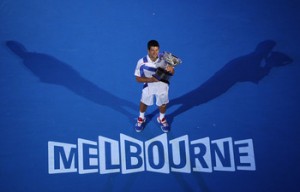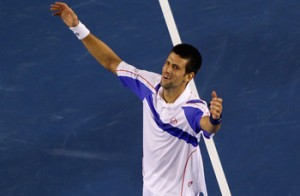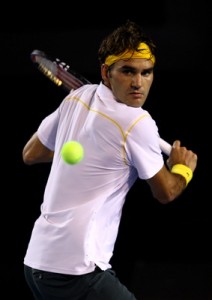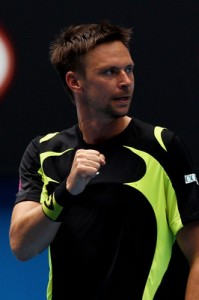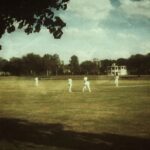Men’s Tennis Power Rankings: Novak Djokovic Triumphs Down Under
It lasts just a fortnight. But the first Major of the year, the Australian Open, has shown just how much water can flow under the bridge in two short weeks.
With the draws made, the pundits placed their bets, the journos made their predictions and the fans prepared their banners. Everyone had a view on who would take to the court on the final day.
There were column inches on whether home favorite Lleyton Hewitt could make one last assault on the tournament. There was high excitement surrounding the return of former world No. 4, Juan Martin Del Potro. And there was the newly-promoted world No. 4 Robin Soderling to assess: was he really on a par with ‘the top four’?
Possible upsets were, as usual, eagerly sought. Gilles Simon, the proud owner of the most recent ATP title in Sydney, met Roger Federer in round two. It was tough, but the reigning Australian champion forged onward and upwards, and the odds on his retaining the title shortened with each successive win.
Then there was Tomas Berdych rediscovering his Wimbledon form at just the right time. He made it effortlessly into the quarterfinals, as did the long-life-battery-driven David Ferrer and the new-Swiss-on-the-block, Stanislas Wawrinka: dangerous dark horses, all of them.
And, as with every Major tournament, a new talent strode into the limelight to thrill the lovers of the underdog. Take a bow, Alexandr Dologopolov.
But few really doubted that the dominant four of men’s tennis would eventually take their allotted semi-final places: Federer and Novak Djokovic, Rafael Nadal and Andy Murray.
And, tough call though it was, the final was almost certainly destined to be Roger-and-Rafa. After all, one or the other had featured in every Major bar one for the last six years and they had won all but two of the last 23.
But 14 days proved to be a mighty long time in the unfolding story of 2011’s first Major and, in the end, the Earth seemed to pause on its axis while it adjusted to the prospect of a final without either top seed in attendance.
Instead it came down to the two men widely regarded as the second pair in the tennis hierarchy.
They have been bracketed together for years, yoked by their ages (they were born in the same week), the weight of expectation, their struggles to keep emotions in check and with sparkling talent at their disposal.
And they are, in the first Power Rankings of 2011, yoked together in the two top spots. More significantly, there’s a real sense that the duopoly of the last six years is under threat.
The Nos. 1 and 2 in the world may have to get used to some company in their tennis stratosphere.
1. Novak Djokovic
Last Power Ranking: 4; ATP Ranking: 3
Last Four Tournaments: Australian Open (Winner), World Tour Finals (Semifinals), Paris (R16), Basel (Finals).
Power Ranking Points: 2,071
If this year’s Australian Open was proving that two weeks is a long time in tennis, it also showed that two hours 40 minutes can be just as significant: in fact significant enough to raise one player to an entirely new status. That was all it took to lay open the difference between the two men who have so much in common.
Djokovic and Murray frequently practise together, played their first Major and won their first ATP title in the same year, lost their first Major final to Federer in the U.S. Open. They both also came to Australia in good form.
But Djokovic had had something about him since his first win over Federer in the U.S. Open. With three finals and two semifinals in his last six ATP events, he took on the look of a man ready to step up to challenge the top two.
Following Serbia’s Davis Cup victory, he had simply burgeoned with confidence, his shoulders growing broader before the eyes, his head held higher. His form in Melbourne stoked that confidence with a resounding win over Berdych, and his tennis against Federer in their semi-final was nothing short of superb.
Against Murray, he never looked like losing and played off both wings with a now-familiar precision and power to both deep corners of the court.
His serve, of such concern in the early stages of 2010, set up his complex web of tactics to perfection. With a scattering of deft lobs and accurate volleys, Djokovic’s tennis has become a formidable combination.
The brash confidence that won the Serb his first Australian title at just 20 has now been reined in and honed into a mature confidence that has allowed his talent to flower. He is combining a solid, patient game of tactical intelligence with an athleticism that is the equal of any man on the tour.
He is fast and accurate, aggressive but with outstanding defensive skills. It’s a crowd-pleasing package, and it has now broken the Federer-Nadal stranglehold on the Majors.
The confidence continues to grow. He has already announced his intention to target Wimbledon, and he is close to overtaking Federer in the rankings—though that immediate ambition has been put on hold by his withdrawal from Rotterdam with a shoulder injury.
So roll on Dubai: the next venue where they could play out the fight for those top-two places again.
2. Andy Murray
Last Power Ranking: 3; ATP Ranking: 5
Last Four Tournaments: Australian Open (Finals), World Tour Finals (Semifinals), Paris (Quarterfinals), Valencia (R16).
Power Ranking Points: 1,258
The style of Murray’s loss to Djokovic in the Australian final—much like his loss to Federer last year—was the surprise.
He had surged through tournaments on the outdoor hard courts during the latter stages of 2010, taking Masters titles in Toronto and Shanghai and the scalp of Federer in both. He reached the semis of the WTFs—and very nearly the finals, too.
As the No. 5 seed in Australia—he forsook the ATP schedule and its points in favor of the Hopman Cup—Murray could have met one of the three top seeds in the quarterfinals: Nadal, Federer or Djokovic. The draw was kind, though, and he was not scheduled to meet any until the semis.
Things got even better. Ferrer’s removal of an injured Nadal and Dolgopolov’s defeat of Soderling meant that Murray had to beat just one top-10 player—Ferrer himself—to reach his third Major final. His progress was so straightforward that U.K. journalists were slating this as the perfect opportunity to break his Major duck.
Much as he and Djokovic have in common, though, Murray looked the rookie when it came to the final showdown. He retreated behind the baseline played his best counterpunching tennis, but that was not enough against such incisive hitting, and a dogged defence that turned to attack in a trice.
Murray ranted; Djokovic remained imperious.
Murray has since said—he always does in these situations—that he will go away and work harder. Perhaps he should consider going away and finding a coach who will ingrain positive tactics and a positive mindset into his tennis.
He has ability in spades—and he proved he has an attacking game in his beating of Federer in Shanghai.
He has the chance to fight it out with the current No. 4, Soderling in Rotterdam next week, but which Murray will turn up is anyone’s guess.
3. Roger Federer
Last Power Ranking: 1; ATP Ranking: 2
Last Four Tournaments: Australian Open (Semifinals), Doha (Winner), World Tour Finals (Winner), Paris (Semifinals).
Power Ranking Points: 963
Since his quarterfinal loss at Wimbledon, Federer went on to win 29 out of 33 matches during seven tournaments.
He put together a match-packed, hard-court six weeks that began in Shanghai and concluded with an unbeaten run in London—23 matches in six weeks—and looked as strong in beating both Djokovic and Nadal in the last event as he had in his opening wins over Djokovic and Soderling in China.
The wily eye of Paul Annacone, a determination to play old-fashioned attacking tennis, a retooled missile of a back-hand drive and a wide kicker of a serve brought their reward and made him the man to beat in Melbourne, especially as he had won the prestigious season opener in Doha on the way.
But his run in Australia was tested early by Simon in a fascinating five-setter. That win, followed by a distracted performance against Xavier Malisse in the third round, seemed to sharpen the Federer concentration.
By the time he took on Wawrinka—himself rolling over Gael Monfils and Andy Roddick like a steamroller—the Federer machinery was purring: a 77 percent first serve score and just 24 unforced errors against his hapless compatriot.
So when Federer and Djokovic came head-to-head in the semis, it had the feel of a finals showdown. It was their 20th meeting and their seventh in a hard-court Major. Djokovic had scored a famous victory over Federer in New York but the Swiss had won their three subsequent matches.
Few expected Federer to lose in straight sets, but he did. It was closer than that suggests: a tie-breaker and a 7-5 second set, with breaks aplenty on both sides.
4. David Ferrer
Last Power Ranking: 7; ATP Ranking: 6
Last Four Tournaments: Australian Open (Semifinals), Auckland (Winner), World Tour Finals (RR 3 losses), Paris (R16).
Power Ranking Points: 849
It was after his second round exit in Melbourne last year that Ferrer considered throwing in the towel at the end of the season.
Instead, he came back like a charging bull with two finals by the end of February—one reaping a title.
His clay season went from strength to strength but he went on to prove his worth on the hard courts at the end of the year as well. He qualified for the WTFs and looked trim, eager and fast in beating David Nalbandian in Auckland just ahead of the Australian Open.
He had few impediments before the semifinals but then he faced Nadal who had won 11 of their 14 encounters and the last seven in a row. It seemed a foregone conclusion that Nadal would walk to the finals. But in the second game, Nadal pulled a thigh muscle and played the rest of the match in third gear.
It was difficult for both men, of course: friends off the court and so much at stake on court. Ferrer did well to focus and he did even better to take Murray to four sets in the semis—two of them tie-breakers.
Ferrer is popular, gritty, dedicated and modest, and he maximises every ounce of his talent. He is also enjoying, at close to 29, his highest ranking since October 2008 and the kudos of being Spain’s No. 2 player. That’s close to his best ever form.
He, like several other men, has begun to attack the net with a little more confidence and seems, against the odds, to be playing better and better tennis on the hard court.
He has not made an early run for the South American clay, either, but is headed to Rotterdam after a week’s break to muscle in on the big boys—and possibly another head to head with Murray.
He’s never had great success there on his infrequent visits, but maybe this time it will be different.
5. Rafael Nadal
Last Power Ranking: 2; ATP Ranking: 1
Last Four Tournaments: Australian Open (Quarterfinals), Doha (Semifinals), World Tour Finals (Finals), Shanghai (R16).
Power Ranking Points: 488
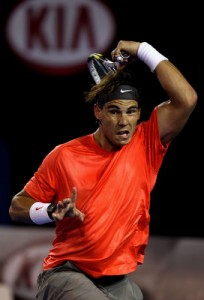
Rafael Nadal who held three of the last four major championships could not find a way to win in Australia.
Nadal ended 2010 head and shoulders above the rest in the rankings, with seven titles from nine finals—three of the wins in Slams—and a 71-10 win-loss ratio.
He became the youngest man in the Open era to win a career Slam, the first ever to win the “Clay Slam” and in Australia was aiming to claim a complete Slam—the first to hold all four Majors in one go since Rod Laver.
And his Australian draw did not appear to impose too many stresses on the Nadal game right the way through to the semis. In Marin Cilic, his quarterfinal opponent, he met a man floundering with his form and faced possibly the most benign of the top eight seeds, Ferrer, in the semis.
Then out of the blue, Nadal pulled a thigh muscle in the second game and was run ragged into a straight sets defeat. It was a heartbreaker: a repeat of his exit at the same stage in last year’s event.
It also showed the class of the man. He payed his friend the ultimate courtesy of playing his hardest to the bitter end and then refused to talk of injury in his press conference.
Nadal has announced that he will be back in training by next week. He did not play Dubai last year, and so has no need to defend points there this time round, so will resume competitive tennis at the Davis Cup tie on March 4.
Although he cannot be caught, points-wise, until May—even if he doesn’t play a single match—he has huge points to defend throughout 2011—he fell short of the quarters only once in the whole of 2010. That will be the only incentive for the chasing pack as it pursues the most demanding opponent in tennis.
6. Stanislas Wawrinka
Last Power Ranking: NR; ATP Ranking: 14
Last Four Tournaments: Australian Open (Quarterfinals), Chennai (Winner), Paris (R16), Valencia (R16).
Power Ranking Points: 454
Wawrinka has been one of the surprise packages of the last six months. He had pedigree, of course, reaching the top 10 in the summer of 2008. Then he dropped, after a first-round loss at Wimbledon last year, to within a hair’s breadth of slipping into the 30s.
So he dropped his life-long coach in favor of one of Federer’s early mentors, Peter Lundgren, and he hasn’t looked back. Almost immediately, he reached his first Major quarterfinal at the U.S. Open and this year he won only his third ATP title—his first on hard courts—in Chennai.
He played another stormer in Melbourne, sweeping through the talented Grigor Dimitrov, Monfils and then Andy Roddick without losing a set.
Wawrinka does not fit the usual tennis blueprint. Barely six feet tall, he is stocky and barrel-chested, but he has fast feet, great weight of shot and serve and arguably the best backhand in the game.
Against Roddick, it was a truly formidable combination: 24 aces and 67 winners. Against Monfils it was 11 aces and 57 winners—and these were not long matches.
But then faced, for the fourth time in less than a year, the man in whose shadow he has been fated to stand, and Federer turned it on with style, conceding just seven games to his fellow Swiss.
But these are good signs for Wawrinka. He’s become a man that no one wants to see in their quarter, and he is not far off achieving his declared ambition of reaching the top 10 again.
He jumped from 19 to 14 with his Melbourne performance, but has now forsaken the hard courts to head to Argentina. It will be interesting to see whether he still finds clay to his liking.
7. Tomas Berdych
Last Power Ranking: NR; ATP Ranking: 7
Last Four Tournaments: Australian Open (Quarterfinals), Chennai (Semifinals), World Tour Finals (RR 1 win/2 losses), Paris (R16).
Power Ranking Points: 410
After a semi showing in the French Open and a place in the Wimbledon final, the form of the towering No. 7 seed went walkabout in the latter stages of 2010. Since those heady summer days, he had not won more than two matches in a tournament.
There were signs that the sleeping giant was stirring at the WTFs when he scored his only win of the year against Roddick and he then reached the quarterfinals in his 2011 opener in Chennai.
Talent will out, and despite a tricky early draw in Melbourne, Berdych lost just one set on his way to a quarterfinal playoff against Djokovic. The Czech’s demolition of Fernando Verdasco in the fourth round was particularly impressive: he made only eight unforced errors against 32 winners.
He claims to have focused on developing his attacking game during the offseason and made regular forays to the net—with some success—in Melbourne. It’s good to see the newest arrival in the top 10 marshalling his formidable physical skills with a greater mix of tactics.
A slow developer, Berdych may well have a lot more to bring to the tour in 2011, and his first chance will be in Rotterdam where he will attempt to get past the second round for the first time in six attempts.
8. Alexandr Dolgopolov
Last Power Ranking: NR; ATP Ranking: 32
Last Four Tournaments: Australian Open (Quarterfinals), Sydney (Quarterfinals), Brisbane (R16), Basel (R32).
Power Ranking Points: 380
A quick look at the rankings after the Australian Open tells something of the exciting story that the young Ukrainian brought to Melbourne. His Oz performance lifted Dolgopolov 14 places to 32—a career high—and more than 80 higher than this time last year and not far short of 300 up on the same time in 2009.
The rapid rise this slight built, middle-height 22-year-old is all the more noteworthy because of style of play with which he has achieved it.
Dolgopolov is a jumping bean of a man who can apply shocking amounts of spin, fire off lunging and plunging ground-strokes and hit his serve almost before his ball toss is complete (and managed to end the Open with the fourth highest number of aces!).
His play is creative and charismatic. It has also, in the past, been unpredictable but as he matures, this man is showing signs of bringing more self-control and self-belief to the big occasion.
In Melbourne, he took out No. 13 Jo-Wilfried Tsonga and then did the same to a shocked Soderling. In both cases, he lost the first set and eventually won in five. In both, there were bouts of hot and cold. But in both, he played with a fresh and infectious style of tennis that set the headlines alight.
His unconventional game challenged the Murray concentration, too, and he took a set off the Scot for the first time in the tournament, but eventually succumbed in four.
Dolgopolov heads to South America—Buenos Aires if he can work out how to get a visa, but maybe Acapulco if he can’t!
This time last year, he went off to play clay court Challenger events. This year, he’s broken into the big time.
There’s no question he will prove to be a thorn in the side of more top-20 players as the season unfolds. And there’s no doubt his gentle humor and his entertaining tennis will gather a growing following, too.
9. Robin Soderling
Last Power Ranking: 5; ATP Ranking: 4
Last Four Tournaments: Australian Open (R16), Brisbane (Winner), World Tour Finals (RR 1 win/2 losses) Paris (Winner).
Power Ranking Points: 313
Despite a Round Robin exit in the WTFs, Soderling had another good year in 2010 under the intelligent and calming eye of Magnus Norman.
It therefore came as a surprise when he announced a split from Norman in December and quickly took up with Claudio Pistolesi.
Soderling spent the offseason at a training camp working on his attack game, and especially his net game. He certainly showed signs of a willingness to adopt a more varied attack in Melbourne, but he was like a rabbit caught in the headlights against the flamboyant game of Dolgopolov. He made a shock fourth round exit after a very assured progress through the early rounds.
Soderling already has one win under his belt this year, in Brisbane, and will fancy his chances back indoors in Rotterdam, where he is the defending champion.
He is also still in the top four, though Murray will be trying to reclaim that spot next week.
10. Andy Roddick
Last Power Ranking: 10; ATP Ranking: 8
Last Four Tournaments: Australian Open (R16), Brisbane (Final), World Tour Finals (RR 3 losses), Paris (Quarterfinals).
Power Ranking Points: 246
Things were looking pretty good for Roddick when he came to Melbourne. He’d reached the finals in Brisbane and did not face too many tripwires in the early rounds of the Open.
Looking towards his predicted quarterfinal place, he must have wondered what he’d done to face his nemesis in another Major: Federer holds a 20-2 record over the American. What Roddick did not expect was a battering instead from the Swiss No. 2 in the fourth round.
His consistency and persistence is without parallel. Roddick is the only active player apart from Federer to finish in the top 10 for the ninth straight year and to win at least one title for 10 straight years.
Last year, he enjoyed particular success in his homeland with the Masters title in Miami and a final finish in Indian Wells, and it seems that he has decided to begin his 2011 campaign, as he did last year, with the 500 in Memphis.
But his serve is no longer enough of a weapon on its own to take control of matches against the returning skills of the top men. Does he have anything new to bring to the table that will really disturb them: the cross-court venom of a Wawrinka or the surprising spin of a Dolgopolov, for example?
It is looking increasingly unlikely.
